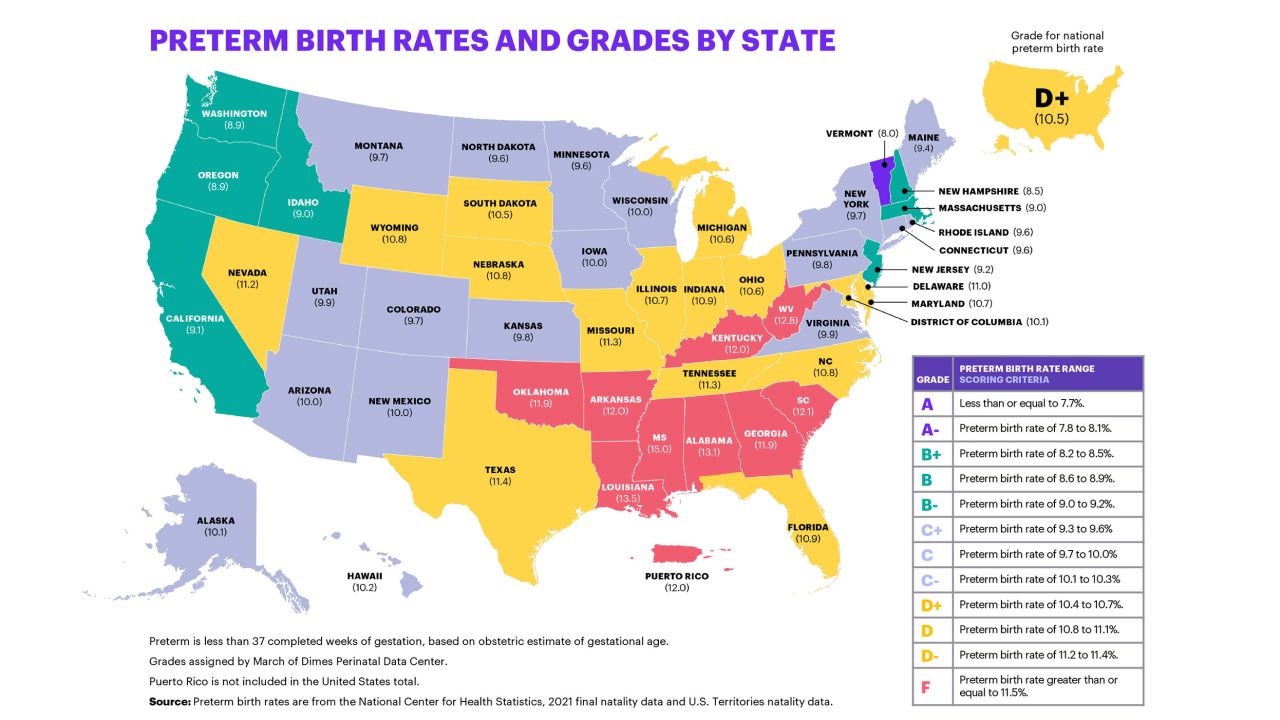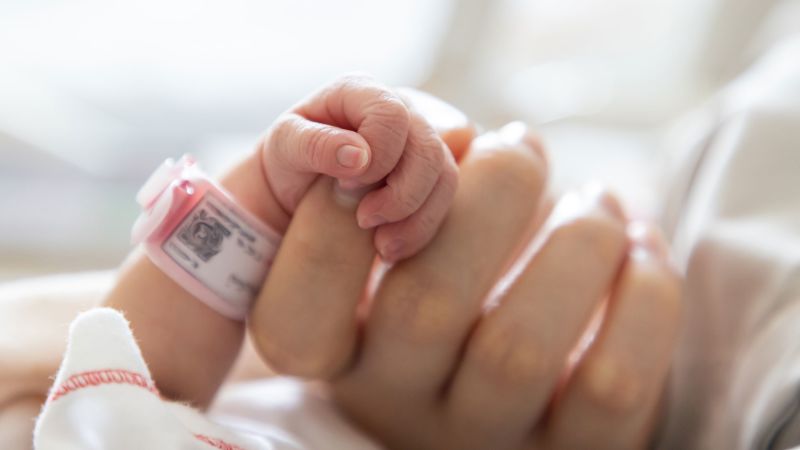CNN
—
The rate of premature birth in the United States is climbing, according to the infant and maternal health nonprofit March of Dimes.
On Tuesday, the organization released its annual “report card” on maternal and infant health, which involves a newly updated calculation system. Taking an in-depth look at premature births, the new report found that the US preterm birth rate rose to 10.5% last year, representing an increase of 4% since 2020 and the worst national rate since March of Dimes started tracking this data in 2007, based on its new calculation system.
“This is actually a 15-year high in the preterm birth rate in this country,” said Dr. Zsakeba Henderson, senior vice president and interim chief medical and health officer at March of Dimes.
The US preterm birth rate peaked in 2006 at 12.8%, according to data from the National Center for Health Statistics.
Since then, some March of Dimes reports have found US preterm birth rates much higher than 10.5%, but those rates were based on calculations that have since been updated, according to March of Dimes.
“There are too many babies being born too soon: 1 in 10. If you were to have 10 babies in front of you and one of them is having to face the complications that comes with prematurity, that’s unacceptable, and we need to do better,” Henderson said, adding that those 1 in 10 are more likely to be Black, American Indian or Alaska Native.
March of Dimes data in the new report shows that infants born to Black and Native American mothers are 62% more likely to be born preterm than those born to White women.
The new March of Dimes report also highlighted state-by-state differences in the rate of babies born prematurely across the country.
The report grades a preterm birth rate less than or equal to 7.7% as an A and a preterm birth rate greater than or equal to 11.5% as an F.
The national preterm birth rate of 10.5% is graded as a D+.
No state has achieved an A rate, and only one has a state-level preterm birth rate that would be graded as an A-: Vermont, which has the lowest preterm birth rate in the US at 8%.
Meanwhile, nine states and one territory have preterm birth rates that received an F grade: Georgia and Oklahoma with 11.9%; Arkansas, Kentucky and Puerto Rico with 12%; South Carolina with 12.1%; West Virginia with 12.8%; Alabama with 13.1%; Louisiana with 13.5%; and Mississippi with the highest preterm birth rate of all states at 15%.

“The areas that have the worst grades are the same areas we’ve been seeing consistently for a long time, and it’s past time for us to do what we need to do to make health better and make our country a better place to give birth and be born,” Henderson said. “It’s unfortunate that we don’t have policies in place to protect the most vulnerable in our country, and without protecting our moms and babies, we can’t secure the health of everyone else.”
To address these state-by-state disparities in preterm births and help improve the national preterm birth rate as a whole, March of Dimes has been advocating for certain policies, Henderson said, including the Black Maternal Health “Momnibus” Act of 2021, a sweeping bipartisan package of bills to provide pre- and postnatal support for Black mothers – but most of the bills in the package are still making their way through Congress.
March of Dimes also has been urging more states to adopt legislation expanding access to doulas and midwives, among other maternal health care services, and reduce the prevalence of maternity care deserts across the country.
There are many potential factors contributing to the nation’s rising preterm birth rate, and Henderson said the Covid-19 pandemic remains one of the biggest.
“We cannot forget about the impact of the Covid-19 pandemic and recognize that there is likely a huge contribution of that, knowing that Covid-19 infection increases the risk of preterm birth,” she said. “But we also know that this pandemic brought many other issues to the forefront, knowing that issues around structural racism and barriers to adequate prenatal care, issues around access, were brought to the forefront during this pandemic as well.”
She added that many mothers in the United States are starting pregnancies later in life, and there has been an increase in mothers with chronic health conditions, who are at higher risk of having to give birth early due to pregnancy complications.
Henderson also said that preterm birth is one of the top causes of infant deaths and disproportionately affects babies born to women of color.
“The United States is one of the worst places to give birth and be born among industrialized countries, unfortunately. When we look at maternal deaths and infant deaths, we’re at the bottom of the pack among countries with similar profiles in terms of gross domestic product,” Henderson said. “It’s because of our disproportionate numbers of preterm births – particularly for populations that are disproportionately impacted, such as Black families and American Indian and Alaskan Native families – that our rates are so much higher than other countries.”
Globally, about 10% of births are preterm worldwide – similar to the US preterm birth rate.
About 15 million babies are born preterm each year, amounting to more than 1 in 10 of all births around the world, according to the World Health Organization, which has called prematurity an “urgent public health issue” and “the leading cause of death of children under 5.”
Separate from the March of Dimes report, WHO released new guidelines Tuesday on how nations can improve survival and health outcomes for babies born too early, at 37 weeks of pregnancy or less, or too small, at 5½ pounds or less.
These WHO recommendations advise that skin-to-skin contact, also known as kangaroo mother care, be provided to a preterm infant immediately after birth, without any initial time spent in an incubator.
“Previously, we recommended that kangaroo mother care to only be for babies that were completely stable,” said pediatrician Dr. Karen Edmond, medical officer for newborn health at WHO, who was the lead on the new guidelines.
“But now we know that if we put babies in skin-to-skin contact, unless they are really critically ill, that this will vastly increase their chances of surviving,” she said. “So what’s new is that we now know that we should provide kangaroo mother care immediately after birth, rather than waiting until the baby’s stable.”
Edmond added that immediate kangaroo mother care can help infants better regulate their body temperature and help protect against infections, and she said that these guidelines are for on-the-ground health care providers as well as families.
The new WHO guidelines also recommend that emotional, financial and workplace support be provided for families of babies born too early or at low birth weights.
“Preterm babies can survive, thrive, and change the world – but each baby must be given that chance,” WHO Director-General Tedros Adhanom Ghebreyesus said in a news release.
“These guidelines show that improving outcomes for these tiny babies is not always about providing the most high-tech solutions,” he said, “but rather ensuring access to essential healthcare that is centred around the needs of families.”
